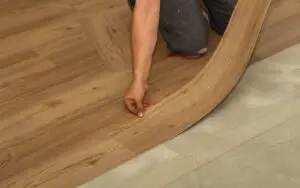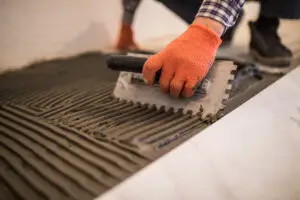Pre-Installation Planning and Assessment
Evaluating Your Current Flooring
Assessing the Condition of Old Flooring
Before installing new flooring, assess the condition of your old flooring. Are there any signs of damage, such as cracks, loose planks, or moisture issues? This assessment will help you determine whether the old flooring needs to be removed or if it can be used as a base for the new flooring. Understanding the condition of your old flooring is an essential step in the preparation process.
Determining Removal Needs
Determine whether the old flooring needs to be removed before you begin with your new floor installation. Removing old flooring can sometimes be a difficult task, and it may require specialized tools. Professionals can assess the type of flooring and know the best methods for removal. Proper assessment and removal can help prevent damage to the subfloor, and ensure a proper installation with the new flooring.
Inspecting the Subfloor
Identifying Any Issues
The subfloor is the foundation of your new flooring, and it’s crucial to inspect it carefully. Look for signs of damage, such as cracks, unevenness, or moisture issues. Any problems with the subfloor must be addressed before you begin the installation process. If not addressed, these problems will transfer into your new floor, and potentially cause it damage.
Addressing Subfloor Damage
If you identify any damage to the subfloor, such as cracks, holes, or unevenness, it needs to be properly repaired. Depending on the type and amount of damage, this may involve filling in cracks, patching holes, or even leveling the entire subfloor. Professional installers have the experience to properly assess and repair the subfloor to ensure a smooth and even surface for your new flooring.
Preparing the Space for Installation
Clearing the Room
Removing Furniture and Obstacles
Before installation, remove all furniture, rugs, and other obstacles from the room. This ensures that the installation area is free and clear, allowing installers to work efficiently and safely. By clearing everything out of the room, you are ensuring that there will not be any delays or safety issues.
Protecting Adjacent Areas
Protect any adjacent areas by covering them with plastic sheeting or drop cloths. This will help to prevent dust and debris from spreading into other rooms during the installation process. This is a step that is often overlooked but is very important in keeping the entire property clean and safe during installation.
Cleaning the Subfloor
Sweeping, Vacuuming, and Mopping
Once the area is clear, thoroughly clean the subfloor. Start by sweeping or vacuuming to remove dust, debris, and any other loose particles. Follow up with mopping or cleaning solution as required to ensure that the surface is completely clean and ready for installation. The cleaner the subfloor, the better the installation will be and the longer the floor will last.
Removing Debris and Residue
Make sure that any remaining debris, adhesive residue, or other contaminants are removed from the subfloor. This will prevent any problems with the installation and ensure the longevity of your new flooring. A clean subfloor will make for a cleaner, safer, and more successful installation.
Essential Subfloor Preparation
Leveling the Subfloor
Using Leveling Compound or Shims
If the subfloor is uneven, you’ll need to level it before installation. This may involve using a leveling compound to fill in any dips or low spots, or using shims to correct any high spots. Leveling the subfloor will prevent any issues from appearing in the new flooring. Professional installers have the tools and knowledge to properly level a subfloor for a long-lasting and beautiful floor.
Ensuring a Smooth Surface
Proper leveling of the subfloor ensures a smooth and consistent surface for the new flooring. An uneven subfloor will cause unevenness in the new flooring, which may lead to problems down the line. A smooth subfloor is essential for a professional outcome with new flooring.
Addressing Moisture Issues
Moisture Testing and Mitigation
Before beginning the installation, test the subfloor for moisture content. High moisture levels can cause problems with many flooring types. If needed, implement moisture mitigation techniques, such as dehumidifiers, or moisture barriers, to address any moisture concerns. Proper moisture testing and mitigation are essential for preventing future issues and ensuring the longevity of your new floor.
Using Vapor Barriers or Underlayment
Depending on the type of flooring and the subfloor, you may need to install a vapor barrier or underlayment. These materials help to prevent moisture from damaging the flooring, as well as adding an additional level of cushion and sound reduction. Professional installers will be able to advise on the best solutions for your specific flooring type.
Choosing the Right Flooring Material and Tools
Selecting the Appropriate Flooring
Matching Flooring to Your Needs
Choose a flooring material that matches the needs of the specific space. Consider factors such as durability, moisture resistance, style, and cost. Different rooms may have different flooring requirements. Professional installers can advise on the best type of flooring for your specific needs and budget.
Choosing Quality Materials
Always choose quality flooring materials that will be long-lasting, durable, and aesthetically pleasing. Choosing low-quality materials can often lead to premature wear and tear. Choosing the right material is the first step in ensuring a successful installation, and will ultimately save time and money.
Gathering Necessary Tools and Equipment
Ensuring You Have the Right Tools
Make sure you have all the necessary tools and equipment, such as saws, measuring tape, spacers, and tapping blocks, before you begin the installation process. Having all the tools at your disposal makes for a more efficient and smoother process.
Preparing a Toolkit for Installation
Prepare a toolkit that includes all of the essential tools you will need to prevent unnecessary delays during installation. Keep this toolbox with you during the project so that you are always prepared. Missing one single tool can hold up an entire project.
The Importance of Professional Guidance
Why Professional Installers Are Recommended
Expertise and Precision
Professional flooring installers have the expertise and precision to ensure your flooring installation goes smoothly and correctly. Their knowledge and experience often result in a higher quality finished product, and will leave you with the best outcome.
Warranty and Peace of Mind
Professional flooring installations often come with warranties that guarantee a quality installation. Hiring a professional gives you peace of mind knowing the job was done right, and that you have someone to help if anything goes wrong with the flooring or the install.
How Professionals Handle Preparation
Ensuring Proper Prep is Done Right
Professionals will ensure that all prep work is handled properly. This ensures that the flooring will last longer, look better, and not have any issues that may appear due to improper preparation. They have the tools, skills, and training to ensure that all preparation is done the right way.
Avoiding Costly Mistakes
Improper preparation of your flooring can lead to costly mistakes. Professionals will have the ability to avoid these, and ensure that your project is completed with the highest standards in mind. They can help you avoid unnecessary expenses down the line by doing the prep correctly from the beginning.
FAQs & Answers
Proper subfloor preparation is critical because it provides a stable, level, and dry surface for the new flooring. An uneven or poorly prepared subfloor can lead to issues such as squeaky floors, buckling, or damage to the flooring materials. Professionals are experts in assessing and properly preparing the subfloor, ensuring a smooth and long-lasting flooring installation.
You can identify the need for subfloor leveling by checking for unevenness with a level or straight edge. Visible dips, bumps, or inconsistencies indicate the need for leveling. Professional installers are trained to identify and correct these issues, ensuring that the new flooring is laid on a perfectly level surface.
Preparing your space for flooring installation involves clearing the room of all furniture and obstacles, cleaning the subfloor thoroughly, and ensuring the space is ready for the installation process. Professionals also recommend protecting adjacent areas from dust or debris. Having this preparation done correctly helps the job go smoothly and efficiently.
Common mistakes people make when preparing for flooring installation include neglecting subfloor issues, not properly cleaning the subfloor, or failing to remove all obstacles from the room. In addition to these issues, many also fail to use the proper underlayment or not taking the proper measurements. Professional installers avoid these mistakes, providing you with the peace of mind knowing your floor is in good hands.
While DIY prep may seem like a cost-saving option, professionals are recommended to handle the prep work because they have the knowledge, experience, and tools to properly prepare the area, level the subfloor, and address any potential moisture issues. Professional preparation is crucial to ensuring a high quality outcome that will last for years.





